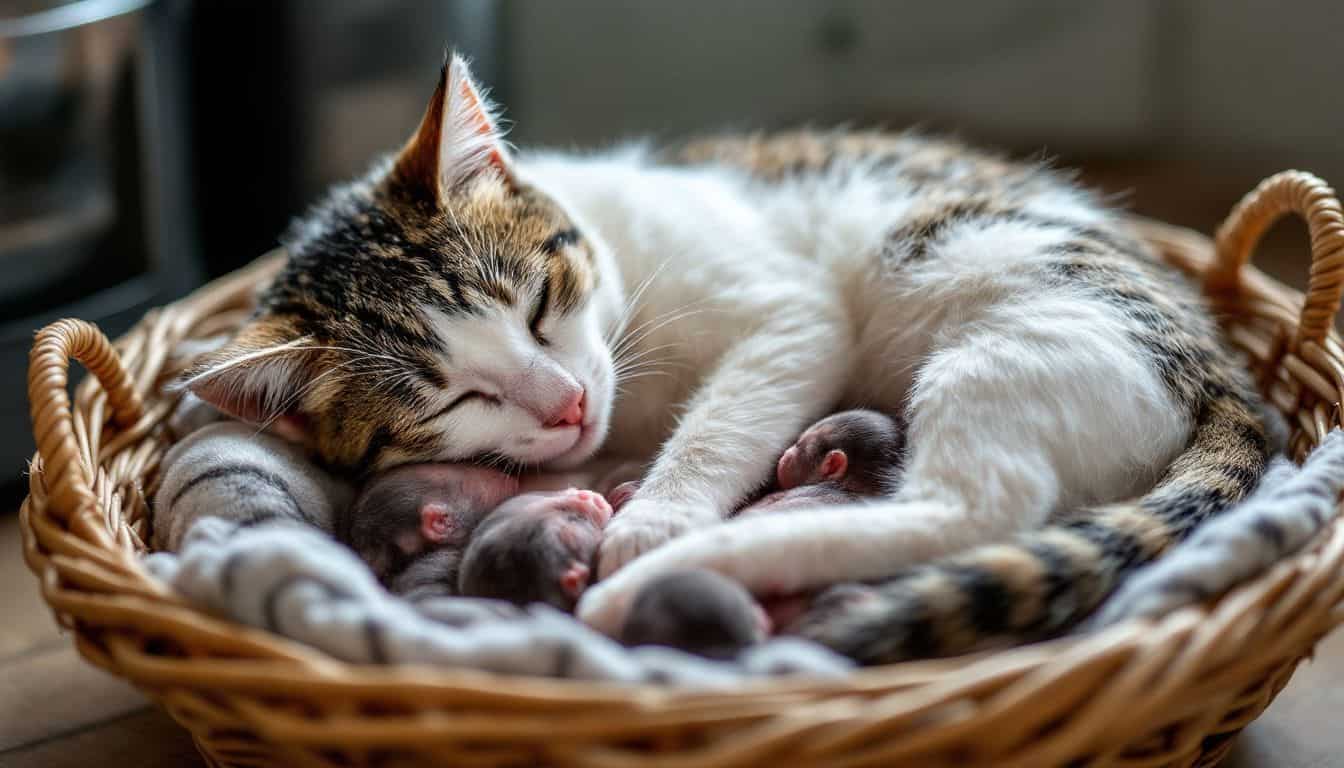
Recognizing when your pregnant cat is ready to give birth can significantly improve her comfort and safety. Female cats often display noticeable changes as the birthing process approaches. You might observe her becoming restless, pacing, or seeking quiet, secure spaces. These behaviors signal her instinct to prepare for labor. Physical signs, such as enlarged nipples or a drop in appetite, may also appear. Understanding these signs can help you provide the care she needs during this critical time.
-
Observe your cat for behaviors like nesting, restlessness, and increased vocalization, indicating she is preparing for labor.
-
Monitor her physical changes, such as a drop in temperature, loss of appetite, and enlarged nipples, as these are key indicators of impending delivery.
-
Create a safe and comfortable nesting area with absorbent bedding and a quiet location to help your cat feel secure during labor.
-
Gather essential supplies like towels, gloves, and a heating pad to assist during birthing and ensure a hygienic environment.
-
Stay vigilant for warning signs that may require veterinary attention, such as prolonged straining or excessive bleeding, to ensure the safety of both mother and kittens.
-
After birth, provide your cat food, water, and a quiet space to recover while closely monitoring her kittens’ health and feeding.
-
Schedule a post-birth veterinary checkup to ensure the health of the mother and her kittens and address any potential complications early.
How Do You Know Cat Is in Labor?
Understanding the signs a cat is going into labor can help you prepare for the arrival of kittens. Both behavioral and physical changes signal that your pregnant cat is nearing delivery. Observing these changes closely ensures you can provide the right care and support during this critical time.
Behavioral Signs of Labor
Nesting behavior and seeking quiet spaces
One of the earliest signs of labor is nesting behavior. Your cat may search for a secluded, quiet spot to give birth. She might gather soft materials like blankets or towels to create a comfortable space. This instinctive behavior ensures a safe environment for her kittens.
If you notice her spending more time in hidden corners or under furniture, she could be preparing for labor.
Restlessness, pacing, and increased vocalization
As labor approaches, your cat may become restless. She might pace around the house or seem unable to settle in one place. Increased vocalization, such as meowing or yowling, often accompanies this restlessness. These behaviors indicate discomfort and the onset of labor.
Please pay attention to these changes, as they clearly show that a cat is going into labor.
Physical Signs a Cat Is Going Into Labor
Drop in rectal temperature and how to measure it
A significant physical indicator of labor is a drop in your cat’s rectal temperature. Normally, a cat’s temperature ranges between 101°F and 102.5°F. When it drops to around 100°F or lower, labor is likely imminent. Use a digital thermometer to measure her temperature gently.
Always handle her with care to avoid causing stress.
Loss of appetite and excessive grooming
Another sign of labor is a sudden loss of appetite. Your cat may refuse food even if she was eating normally before. Additionally, she might groom herself excessively, especially around her abdomen and genital area. This grooming helps her prepare for birthing by keeping the area clean.
Enlarged nipples and milk production
Physical changes in your cat’s body also signal labor. Her nipples may appear larger and more prominent. You might notice milk production, which indicates her body is ready to nourish the kittens. These changes often occur in the final stages of pregnancy and serve as early signs of labor.
Recognizing Active Labor in Cats
The process becomes more intense and visible when your cat enters active labor. Recognizing the signs of active labor ensures you can provide the necessary support and intervene if complications arise. This stage marks the final steps before your cat delivers her kittens.
Signs Your Cat Is Ready to Deliver
Contractions and visible straining
Contractions are one of the most noticeable active labor signs. You may observe your cat’s abdomen tightening as her body works to push the kittens through the birth canal. She might also visibly strain, a natural part of the birthing process. These contractions often come in waves, giving her short breaks in between.
If you notice prolonged straining without progress, it could indicate a problem requiring immediate veterinary attention.
Bloody vaginal discharge and its significance
A small amount of bloody vaginal discharge is normal during active labor. This discharge signals that your cat is ready to deliver her kittens. However, excessive bleeding or discharge with a foul odor could point to complications. In such cases, contacting a veterinarian promptly is essential to ensure your cat’s and her kittens’ safety.
Delivery of Kittens
Timing between kittens and what’s normal
Once the first kitten is born, the timing between subsequent kittens can vary. Typically, a cat delivers kittens every 30 to 60 minutes. Some cats may take longer breaks, especially if they are first-time mothers. If more than two hours pass without the next kitten arriving, it could indicate a problem. Monitoring the timing helps determine whether your cat is progressing normally or needs assistance.
How to assist if a kitten is stuck
Occasionally, a kitten may become stuck during delivery. If this happens, you can gently assist by using clean hands or gloves to guide the kitten out. Apply light pressure and avoid pulling too hard, which could harm the kitten or cat. If the kitten remains stuck despite your efforts, seek veterinary help immediately.
A veterinarian can provide the necessary care to ensure a safe delivery.
Getting a handle on these bits about active labor helps you be there for your cat when she needs it. Keeping cool and paying attention lets you see when she’s about to give birth and jump in if anything goes wrong. Remember to put your cat’s comfort and safety first the whole time.
How to Prepare for Your Cat’s Labor
Creating a Safe and Comfortable Nesting Area
Materials needed for the nesting space
Gather essential materials to create a cozy and hygienic nesting area. Line the space with absorbent bedding like towels or blankets. These materials provide comfort and help keep the area clean during delivery. Include absorbent pads to manage fluids and maintain cleanliness.
For warmth, add warm blankets or a cat-safe heating pad. Ensure the heating pad is chew-resistant and maintains a safe temperature to avoid overheating.
Choosing the right location for the birthing area
Pick a quiet, secluded spot in your home for the birthing area. Cats prefer privacy during labor, so choose a location away from household noise and foot traffic. A small room or a corner with minimal disturbances works well. Place the nesting materials in a box or a low-sided container to give your cat easy access while keeping the kittens secure.
Ensure the area stays warm, maintaining a temperature between 85-90°F, especially during the first few days after birth.
Gathering Essential Supplies
Items like towels, gloves, and heating pads
Having the right birthing supplies on hand can make a big difference. Stock up on absorbent towels to clean the kittens and keep the area dry.
Use non-latex disposable gloves to handle the kittens or assist your cat during delivery. A heating pad or heat lamp helps maintain a warm environment for the kittens, as they cannot regulate their body temperature immediately after birth.
Emergency supplies for complications
Gather emergency supplies to prepare for potential complications. Keep sterile scissors and thread nearby if you need to cut an umbilical cord. Have a bulb syringe ready to clear a kitten’s airway if necessary. Include a small scale to weigh the kittens and monitor their growth.
Keep your veterinarian’s contact information accessible for immediate assistance if complications arise.
Monitoring Your Cat During Labor
How often to check on your cat
During labor, check on your cat periodically without disturbing her. Observe her behavior from a distance to ensure she feels secure. Frequent interruptions can cause stress, so limit your presence to brief moments. Let her handle the process naturally if she seems calm and progressing normally.
Signs that indicate your cat needs help
Stay alert for signs that your cat may need assistance. Prolonged straining without delivering a kitten, excessive bleeding, or visible distress are red flags. If you notice these issues, contact your veterinarian immediately.
Early intervention can prevent complications and ensure your cat’s and her kittens’ safety.
Preparing thoroughly for your cat’s labor helps create a safe and supportive environment. With the right nesting area, essential supplies, and careful monitoring, you can confidently help your cat through this important moment.
Potential Challenges During Cat Birth
Knowing about possible issues that might come up during childbirth can help you react fast if something goes wrong. While most cats deliver their kittens without issues, some situations require immediate attention to ensure the mother’s and her kittens’ safety.
Prolonged Labor
How long is too long between kittens
During birth, a cat typically delivers kittens every 30 to 60 minutes. However, delays longer than two hours between kittens may indicate a problem. If your cat has been straining for more than 20–30 minutes without producing a kitten, this could signal an obstruction or other complications.
Prolonged labor increases the risk of exhaustion and distress for your cat. Monitoring the timing between each kitten is crucial to identify when intervention might be necessary.
When to contact a veterinarian
Contact your veterinarian immediately if your cat shows signs of prolonged labor. Straining without progress, excessive panting or visible discomfort are red flags. A veterinarian may need to manually assist in the delivery or perform an emergency procedure, such as a cesarean section, to save the mother and kittens.
Acting promptly can prevent severe complications during cat birth.
Kitten or Placenta Retention
Signs of retained kittens or placentas
Retained kittens or placentas pose serious risks to your cat’s health. Signs include persistent straining after the last kitten is born, a foul-smelling vaginal discharge, or visible distress. Your cat may also appear lethargic or refuse to care for her kittens.
These symptoms suggest that part of the birth process remains incomplete.
Why this requires immediate medical attention
Retained kittens or placentas can lead to infections or life-threatening conditions like sepsis. Immediate veterinary care is essential to remove any retained tissue and prevent further complications. A veterinarian will perform an examination and may use medication or surgical intervention to resolve the issue.
Early detection and treatment ensure a smoother recovery for your cat.
Maternal Exhaustion
Recognizing exhaustion in your cat
Maternal exhaustion occurs when your cat becomes too tired to continue the birth process. Signs include heavy panting, crying, or lying down without attempting to push. She may also ignore her kittens or show signs of distress.
Exhaustion often results from prolonged labor or underlying health issues.
Steps to support your cat if she is struggling
If you notice signs of exhaustion, provide your cat with a calm and quiet environment. Offer water to hydrate her and ensure the nesting area remains warm and comfortable. Avoid disturbing her unnecessarily, as stress can worsen her condition. Contact your veterinarian immediately if she cannot resume labor or appears weak. Veterinary intervention may involve administering fluids and medication or assisting with the delivery to complete the birth process safely.
Understanding these potential challenges equips you to respond effectively during cat birth. Staying observant and prepared ensures you can provide the necessary care and seek professional help. Your quick actions can make a significant difference in ensuring a successful and safe delivery for your cat and her kittens.
Common Mistakes to Avoid During Cat Labor
Intervening Too Early
Why it’s important to let your cat handle labor naturally
Cats instinctively know how to give birth. Their bodies are designed to handle the process without much external help. Intervening too early can disrupt this natural flow. It may stress your cat, slow down labor, or even lead to complications. You should trust her instincts and allow her to progress at her own pace.
Labor can vary in length, so patience is key. Avoid stepping in unless you notice clear signs of distress or complications.
When intervention becomes necessary
While most cats deliver their kittens smoothly, some situations require your attention. If your cat strains for more than 20–30 minutes without delivering a kitten or shows signs of extreme discomfort, intervention may be necessary.
In such cases, contact your veterinarian immediately.
Always observe from a distance before deciding to intervene. This approach ensures that you only intervene when absolutely needed, minimizing risks for both the mother and her kittens.
Not Preparing a Nesting Area
How this can stress your cat
A lack of preparation can cause unnecessary stress for your cat. Without a designated nesting area, she may feel unsafe or unsettled. This stress can delay labor or lead to complications. Cats prefer quiet, secluded spaces to give birth.
They may become restless or anxious if they cannot find a suitable spot. Stress during labor can also affect the kittens, making it crucial to provide a calm environment.
Simple ways to create a safe space
Creating a nesting area is simple and effective. Use a sturdy box or a low-sided container lined with soft, absorbent materials like towels or blankets. Place the nesting area in a quiet, low-traffic part of your home. Ensure the space is warm and free from drafts.
Adding a heating pad under the bedding can help maintain a comfortable temperature. Preparing this space in advance allows your cat to familiarize herself with it, reducing stress when labor begins.
Ignoring Warning Signs
Signs that require immediate veterinary attention
Some warning signs during labor indicate the need for immediate veterinary care. Prolonged straining without delivering a kitten, excessive bleeding, or foul-smelling discharge are red flags. Other signs include visible distress, lethargy, or refusal to care for the kittens. These symptoms suggest complications like retained kittens or placentas requiring professional intervention.
Ignoring these signs can put both the mother and her kittens at risk.
How to stay vigilant without overreacting
Monitoring your cat during labor requires balance. Stay observant, but avoid hovering. Watch for signs of progress, such as contractions or the delivery of kittens. Monitor her behavior and physical condition from a distance. If you notice anything unusual, assess the situation calmly before deciding on the next steps. Having your veterinarian’s contact information readily available ensures you can act quickly.
Staying prepared and vigilant helps you support your cat without causing unnecessary stress.
What Else to Know About Cat Labor
Post-Birth Care for Your Cat and Kittens
Ensuring your cat has food, water, and rest
After giving birth, your cat needs proper care to recover and nurture her kittens. Provide her with easy access to fresh water and high-quality food. Opt for kitten food or a diet your veterinarian recommends, as it offers the extra nutrients and calories she requires during this demanding period. Place her food and water near the nesting area to minimize her need to leave her kittens.
Rest is equally important for your cat. Ensure the nesting area remains quiet and undisturbed. Avoid handling the kittens unnecessarily, as this could stress the mother.
Allow her to bond with her kittens in a calm environment. Keeping the space warm and comfortable helps the mother and her newborns feel secure.
Monitoring the kittens for health and feeding issues
Newborn kittens rely entirely on their mother for warmth and nourishment. Observe them to ensure they nurse regularly and appear active. Healthy kittens should latch onto their mother and feed every two to three hours.
If you notice any kittens struggling to nurse or appearing weaker than the others, consult your veterinarian immediately.
Check the kittens’ weight daily using a small scale. Consistent weight gain indicates they are feeding well. If a kitten fails to gain weight or shows lethargy, it may require supplemental feeding or medical attention. Keep an eye on their body temperature, as kittens cannot regulate it independently.
A warm nesting area, maintained at around 85–90°F, ensures their safety and comfort.
Scheduling a Vet Check-Up
Importance of a post-birth exam
A post-birth veterinary check-up is essential for both the mother and her kittens. This visit ensures that your cat has recovered well from labor and identifies any potential complications early. The veterinarian can assess her overall health, check for infections, and confirm that no kittens or placentas remain inside her uterus. Early detection of issues like retained placentas can prevent severe health problems.
The vet examines the kittens’ physical condition and ensures they are developing normally. This check-up provides an opportunity to discuss vaccinations, deworming, and other preventive care measures. Scheduling this visit within a week of birth helps address any concerns promptly.
What the vet will check for
During the post-birth exam, the veterinarian evaluates several key aspects:
-
Mother Cat: The vet checks for signs of infection, uterine health, and proper milk production. They may also assess her hydration levels and overall energy.
-
Kittens: The vet examines their weight, body temperature, and physical development. They ensure the kittens are nursing effectively and show no signs of congenital issues.
This visit also lets you ask questions about caring for the mother and kittens. The veterinarian can provide guidance on nutrition, hygiene, and any additional steps to support their health. Regular veterinary care ensures a smooth recovery for your cat and a healthy start for her kittens.
Recognizing the signs of labor in your pregnant cat ensures a smoother birthing process. Create a safe, quiet environment where she feels secure. Gather essential supplies like towels and gloves to prepare for any situation. Monitor her closely but avoid unnecessary interference. Stay calm and supportive throughout the process. If complications arise, contact your veterinarian immediately.
Proper preparation and attention can help your cat experience a positive and safe delivery. This moment can be a rewarding experience for you and your feline companion.

In her previous life, Lisa traveled extensively, both for work and leisure. After the pandemic struck, Lisa locked up her luggage and adopted a cat ever since.
Lisa is now an avid cat lover, she devotes most of her free time serving as butler to her adorable feline at home. When she is not with her cat, she can be seen using her phone sourcing for the latest cat supplies online.


